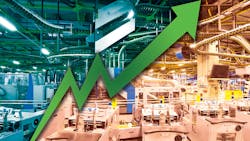Manufacturing growth surged again in February as continued strength in new orders and production drove the continuing rebound from the pandemic collapse.
The Institute for Supply Management PMI Index grew 2.1 percentage points to 60.8% in February. That puts the index 20% above the 50% base level that indicates growth in the index. It’s the second time in three months the index has topped 60%, and it is nearly 50% above the 41.7% reading in April 2020, at the height of the initial COVID-19 pandemic disruption of manufacturing.
Those days are in the past, said Timothy Fiore, chairman of the ISM’s Manufacturing Business Survey Committee, as optimism among the committee members abounds. “The manufacturing economy continued its recovery in February. Survey Committee members reported that their companies and suppliers continue to operate in reconfigured factories,” Fiore said in a press release. “Issues with absenteeism, short-term shutdowns to sanitize facilities and difficulties in hiring workers remain challenges, and continue to cause strains that limit manufacturing-growth potential. Optimistic panel sentiment increased, with five positive comments for every cautious comment.”
PMI component areas continued a strong showing. The New Orders Index was up 3.7 percentage points to 64.8%, the Production Index rose 2.5 percentage points to 63.2% and the Employment Index was up 1.8 percentage points to 54.4%.
Labor is the only issue that continues to restrain the manufacturing index, Fiore said.
“The Employment Index expanded for the third straight month, but panelists continue to note significant difficulties in attracting and retaining labor at their companies and supplier facilities,” he said in the release. “Labor-market difficulties at panelists’ companies and their suppliers continued to restrict manufacturing-economy expansion and will remain the primary headwind to production growth until employment levels and factory operations can return to normal across the entire supply chain.”
This article appeared in Machine Design.
About the Author
Bob Vavra
Senior Content Director, Power & Motion and Machine Design
Bob Vavra is the Senior Content Director of Power & Motion and its sister publication Machine Design. Vavra has had a long career in publishing, media and events. He has covered all aspects of manufacturing for the past 20 years and is a regular attendee at events such as IMTS and Hannover Messe. Vavra is also a sought-after webcast moderator and event emcee, and has presided over events in the U.S., Germany and China.

Leaders relevant to this article:
